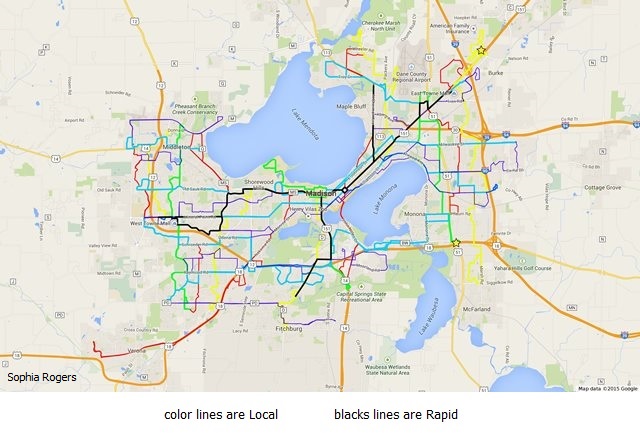A Local AND Streamlined Rapid Public Transit System (PDF)
The Madison Area needs a bus system that has both local and express or rapid buses, as the area has become too large to be served adequately by only one type of bus. Public transportation can expand opportunities for passengers in a practical, relatively inexpensive way while retaining past ridership, shrinking our carbon footprint, alleviating congestion, promoting public health and social equity, lowering household transportation costs, and reducing rates of road accidents.
Despite its lakes and isthmus, the City of Madison has clearly defined corridors for good local and rapid transit that does not require a sharp reduction in the number of stops. Wisconsin's severe weather guarantees ice on the sidewalks every winter, raising serious mobility issues for everyone but especially for elders and disabled people. At the same time, a pedestrian on East Washington Avenue should be able to easily get to Monona Drive, Park Street, University Avenue, Mineral Point Road, or State Street quickly and comfortably without a car. In the schema below, local routes are depicted in colors. Rapid routes are depicted in black.

An Untangled Grid System
The current local system should be untangled as much as possible and adhere to a grid design that has naturally-occurring transfer points. Currently, most routes are hard to follow because they turn constantly instead of moving steadily in the same direction. And although some roads are covered by many buses, passengers can watch several buses pass by before the "right" bus comes. Finally, unsafe and artificial transfer points distort current routing and scheduling and make planning unnecessarily difficult.
Instead of meandering, routes should consistently go in one direction. People need to know that the bus will take them in the direction they want to go. Fewer routes on the same roads enable the same number of buses to travel more frequently, as 10 to 15 minute service is really the minimum frequency without the need for people to plan their trips with schedules, something most are reluctant to do. Finally, a grid system has numerous, naturally-occurring transfer points that negate the need for buses to take the time to deviate from their path for the purpose of going to a large transfer point.
Investment in transit has the potential to provide green jobs and reduce traffic congestion. Although the preliminary schema is developed for buses, heavy ridership on certain routes could justify an eventual upgrade to rail. And although the map emphasizes the City of Madison, the system can potentially cover neighboring communities to become more regional in scope. The goal is for transit to become a popular, convenient and economical way to travel.